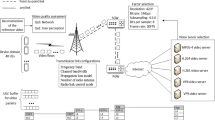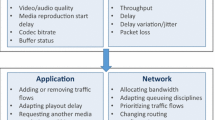Abstract
This paper deals with the analysis of mobile multimedia services, with special focus on current media resolutions for mobile handsets. Since variable network conditions entail variable quality levels, nowadays several applications implement some kind of dynamic service adaptation in order to mitigate these effects. This paper analyzes the service performance from an end-to-end perspective, taking into account the several agents involved in the service provision. From a detailed study, the different possible sources of degradations are identified as well as their impact into the expected quality as perceived by end users. Based on the obtained results, the possible effects of different adaptation capabilities are discussed. The identification of the main source of degradations at the destination endpoint improves the adaptation capabilities and enhances the service performance in terms of perceived quality.







Similar content being viewed by others
Abbreviations
- QoE:
-
Quality of Experience
- CN:
-
Core Network
- AN:
-
Access Network
- NQ:
-
Normal Quality
- HQ:
-
High Quality
- LATM:
-
Low-overhead MPEG-4 Audio Transport Multiplex
- SR:
-
Spatial Resolution
- SBR:
-
Source Bitrate
- VQEG:
-
Video Quality Experts Group
- CT:
-
Content Type
- FR:
-
Frame Rate
- MOS:
-
Mean Opinion Score
- SS:
-
Single Stimulus
- ACR:
-
Absolute Category Rating
- CI:
-
Confidence Interval
- LM:
-
Low-Motion
- MM:
-
Medium-Motion
- HM:
-
High-Motion
- CDN:
-
Content Delivery Network
- IPLR:
-
IP Packet Loss Ratio
- MBL:
-
Mean Burst Length
- fMBL:
-
Frame-level Mean Burst Length
- RLC:
-
Radio Link Control
- AM:
-
Acknowledge Mode
- BLER:
-
Block Error Rate
- TTI:
-
Transmission Time Interval
References
3GPP TR 25.993 (2008) Typical examples of Radio Access Bearers (RABs) and Radio Bearers (RBs) supported by Universal Terrestrial Radio Access (UTRA)
Barreto P, Carvalho P (2008) Hybrid Traffic Model for Multimedia Network Performance Evaluation. In: Proc of the 22nd International Conference on Advanced Information Networking and Applications-Workshops 2008:80–85
Barreto P, Carvalho P, Oliveira R, Ceppo M (2008) Network planning and adaptive routing for multimedia traffic. In: Ma Y, Choi D, Ata S (eds) Challenges for Next Generation Network Operations and Service Management, LNCS 5297, Springer Berlin / Heidelberg, pp 31–40
Boyaci O, Forte A, Schulzrinne H (2009) Performance of Video-Chat Applications under Congestion. In: 11th IEEE International Symposium on Multimedia 2009:213–218
Brunnstrom K, Cermak G, Hands D, Pinson M, Speranza F, Webster A (2008) Final report from the video quality experts group on the validation of objective models of multimedia quality assessment, Phase I, VQEG 2008
Cermak G (2009) Subjective video quality as a function of bit rate, frame rate, packet loss, and codec, In Proc. of First International Workshop on Quality of Multimedia Experience (QoMEX)
Chua TK, Pheanis DC (2006) QoS evaluation of sender based loss-recovery techniques for VoIP. IEEE Netw 20(6):14–22
De Simone F, Naccari M, Tagliasacchi M, Dufaux F, Tubaro S, Ebrahimi T (2009) Subjective assessment of H. 264/AVC video sequences transmitted over a noisy channel. In: Proc First International Workshop on Quality of Multimedia Experience 2009:204–209
Fajardo JO, Liberal F, Bilbao N (2009) Impact of the video slice size on the visual quality for H.264 over 3G UMTS services. In: Proc 6th International Conference on Broadband Communications, Networks and Systems
Hands D, Brunnstrom K (2008) “Multimedia Group Test Plan,” Draft Version 1.24, VQEG 2008
Hillestad O, Jetlund O, Perkis A (2006) RTP-based broadcast streaming of high definition H. 264/AVC video: an error robustness evaluation. J Zhejiang Univ Sci 7:19–26
Ho H, Wolff T, Salatino M, Foley J, Mitra S, Yamada T, Harasaki H (2007) An investigation on the subjective quality of H.264 compressed/decompressed videos. In: Third International Workshop on Video Processing and Quality Metrics for Consumer Electronics
Hohlfeld O (2009) Stochastic packet loss model to evaluate QoE impairments. PIK J 1:53–56
Irini R, Andreja S, Reljin B (2006) H. 264/AVC video compressed traces: multifractal and fractal analysis. EURASIP J Adv Signal Process. doi:10.1155/ASP/2006/75217
ITU-R BT 500–10 (2000) Methodology for the subjective assessment of the quality of the television pictures
ITU-T Rec. J.148 (2003) Requirements for an objective perceptual multimedia quality model
ITU-T Rec. P 910 (1999) Subjective video quality assessment methods for multimedia applications
Jumisko-Pyykko S, Hakkinen J (2005) Evaluation of subjective video quality of mobile devices. In: Proc 13th annual ACM international conference on Multimedia, 2005:535–538
Jumisko-Pyykko S, Hannuksela M (2008) Does context matter in quality evaluation of mobile television? In: Proc 10th international conference on Human computer interaction with mobile devices and services 2008:63–72
Karner W, Nemethova O, Svoboda P, Rupp M (2007) Link error analysis and modeling for video streaming cross-layer design in mobile communication networks. ETRI J 29(5):569–595
Karner W, Svoboda P, Rupp M (2005) A UMTS DL DCH Error Model Based on Measurements in Live Networks. In: Proc. 12 International Conference on Telecommunications
Khan A, Sun L, Ifeachor E, Fajardo JO, Liberal F (2010) Video quality prediction model for H.264 video over UMTS networks and their application in mobile video streaming. In: Proc IEE ICC 2010
Knoche H, Sasse M (2009) The big picture on small screens delivering acceptable video quality in mobile TV. ACM Trans Multimed Comput Commun Appl 5(3):1–27
Korhonen J, Reiter U, Myakotnykh E (2010) On the relative importance of audio and video in the presence of packet losses. In Proc. of Second International Workshop on Quality of Multimedia Experience (QoMEX)
Koumaras H, Lin C, Shieh C, Kourtis A (2010) A framework for end-to-end video quality prediction of MPEG video. J Vis Commun Image R 21(2):139–154
Liu T, Yang H, Stein A, Wang Y (2009) Perceptual Quality Measurement of Video Frames Affected by Both Packet Losses and Coding Artifacts, In Proc. of First International Workshop on Quality of Multimedia Experience (QoMEX)
Raghuveera T, Easwarakumar K (2010) An efficient statistical multiplexing method for H. 264 VBR video sources for improved traffic smoothing. Int J Comput Sci Inf Technol 2(2):51–62
Ries M, Nemethova O, Rupp M (2008) Video quality estimation for mobile H.264/AVC video streaming. J Commun 3(1):41–50
Shu T, Apostolopoulos J, Guerin R (2005) Real-time monitoring of video quality in IP networks. In: International Workshop on Network and Operating System Support for Digital Audio and Video
Staelens N, Vermeulen B, Moens S, Macq J-F, Lambert P, Van deWalle R, Demeester P (2009) Assessing the influence of packet loss and frame freezes on the perceptual quality of full length movies. In Proc. Fourth International Workshop on Video Processing and Quality Metrics for Consumer Electronics (VPQM)
Undheim A, Emstad P (2008) Distribution of loss periods for aggregated video traffic. In: Proc 18 ITC Specialist Seminar 2008:153–160
Undheim A, Emstad P (2009) Distribution of loss volume and estimation of loss for aggregated video traffic. In: Proc 21 ITC 2009
Vukadinovic V, Huschke J (2008) Statistical multiplexing gains of H.264/AVC video in E-MBMS. In: Proc 3rd International Symposium on Wireless Pervasive Computing ISWPC 2008:468–474
You J, Reiter U, Hannuksela MM, Gabbouj M, Perkis A (2010) Perceptual-based quality assessment for audio-visual services: a survey. Signal Process Image Commun 25(7):482–501
Acknowledgement
The research leading to these results has received funding from the European Community’s Seventh Framework Programme FP7/2007-2013 under grant agreement num. 214751/ /ICT-ADAMANTIUM/.
Author information
Authors and Affiliations
Corresponding author
Rights and permissions
About this article
Cite this article
Fajardo, J.O., Taboada, I. & Liberal, F. QoE-driven and network-aware adaptation capabilities in mobile multimedia applications. Multimed Tools Appl 70, 311–332 (2014). https://doi.org/10.1007/s11042-011-0825-y
Published:
Issue Date:
DOI: https://doi.org/10.1007/s11042-011-0825-y




